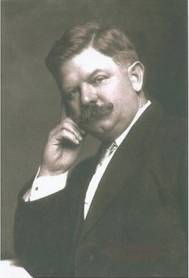The Dream That Had Fins, Page 6
By the time he was 14, Simon Lake had completed his Argonaut plans, left public school, gone to work in his father's foundry, and entered Franklin Institute in Pennsylvania as a part-time student in mechanical drawing. That course ended the formal education of a boy (then 17) who would one day astound the world with a steady stream of marine inventions, design an air lock which would make New York's under-river tunnels possible, patent a plan for a prefabricated house decades before its time, prophesy (in 1898) the use of submarines in under-ice Arctic exploration, amass and lose several fortunes, own a massive shipbuilding plant in Bridgeport, become a marine consultant for several European countries, hobnob with presidents and kings, and win international ac-claim as the father of even-keel submergence — a principle still used in atomic and hydrodynamic submarine design.
The Verne-inspired Argonaut remained on the drawing board for about 13 years, during which time Simon Lake read everything that he could get his hands on. He is said to have practically memorized Has-well's Mechanic's and Engineer's Pocket Book and Steel's Natural Philosophy. In this interim he reworked his submarine plans and took out his first patent, on a steering mechanism for boats and high-wheeled bicycles. Lake also patented a device which eliminated the loud backfiring of the winder on boats engaged in oyster dredging. Apparently there was much oyster pilfering going on in those days and the backfiring of the winder often alerted authorities to the activities of oyster pirates. Of this, Simon Lake wrote, "Many a life was saved by my improved steering gear and my noiseless winders. But how many bushels of oysters were stolen by their aid is anyone's guess."
In 1892 the inventor entered his Argonaut plans in a competition announced by the U.S. Navy in its quest for bids on a submarine. John Holland won that bid. Ironically, Lake's plan was rejected primarily because of its level-keel submergence design, the one feature which was to be a major factor in the future success of submarine building every-where in the world. Disturbed but undaunted by the rejection, Simon Lake decided to build his exploratory dream boat himself, with a small assist from a cousin, Bart Champion. Lacking cap-ital for a full-sized submersible, he settled on a pygmy version and christened it the Argonaut Jr. It was a weird-looking contrivance, about 14 feet long, shaped something like a flatiron, and made of a double skin of pitch pine with canvas stretched between the layers. It was mounted on three wheels, two on either side forward and one aft, a design feature which eventually became a trade-mark of Lake-type boats. The back wheel acted as a steering wheel and was rotated by hand. Compressed air was stored in an ancient soda water tank, and a plumber's hand pump was used as the air compressor. The Argonaut Jr. was also fitted with an air lock and a diver's compartment so "a bottom door could be opened and the operator could walk around the sea bottom and push the boat along with him while he picked up clams and oysters."
This crude contraption, this ugly duckling from which the sleek modern submarine evolved, was sub-merged in July of 1895, on an even keel, off the New Jersey coast at a depth of 16 feet, and remained sub-merged for one hour and 15 minutes.
After the spectacular success of the Argonaut Jr., the young inventor raised sufficient capital to build his full-sized Argonaut. Launched in August, 1897, the Argonaut was the first submarine to be fitted with an internal combustion engine, the first submersible to salvage sunken objects of value (coal and copper), and the source of the first telephone call from a submerged submarine to shore.
Although five men made a 1000-mile cruise in the Argonaut along the Atlantic coast in 1898, and although it survived a severe north-easter in which 200 vessels were lost, the Lake submarine again did not find fas, or with the U.S. Government.
When Jules Verne heard of the second rejection, he sent Simon Lake a message, on August 21, 1898, from which the disheartened inventor is said to have gained new inspiration. The author wrote: "While my book, Twenty Thousand Leagues Under The Dream the Sea, is entirely a work of the imagination, my conviction is that all I said in it will come to pass. A thousand mile voyage in your sub-marine boat is evidence of this. This conspicuous success of marine navigation in the United States will push underwater navigation all over the world."
Jules Verne again proved to be prophetic. By 1901, many of the world's navies were seeking a submarine design which would eliminate the dangerous "porpoising" method of submergence. (Except for Lake's Argonaut, all submarines of that period porpoised through the water to gain enough momentum to force them below the surface, and many of them nosedived to muddy graves). That year Simon Lake founded the Lake Torpedo Boat Company on Seaview Avenue in Bridgeport, and,again with private capital, built his famed Protector, the first fully-tested even-keel submarine. It was such a totally -speculative venture (based on Lake's belief that his submergence design would make all diving-type boats archaic) that at one point in the Protector's construction the inventor could not meet a demand for $17 which he owed. With high hopes, Simon Lake offered his submarine to the United States for consideration first, but, re-buffed for the third time, he sold it to Russia, then at war with Japan. The Protector brought Simon Lake so much acclaim that he became a consultant for the submarine building programs of several (then friendly) European countries, where he opened offices and plants. It wasn't long before most of the world's great navies (except the United States) were building Lake-type submarines, and several others were constructing subs with certain Lake-type features which the inventor had unfortunately neglected to patent abroad.
